Yoshimura history – 19
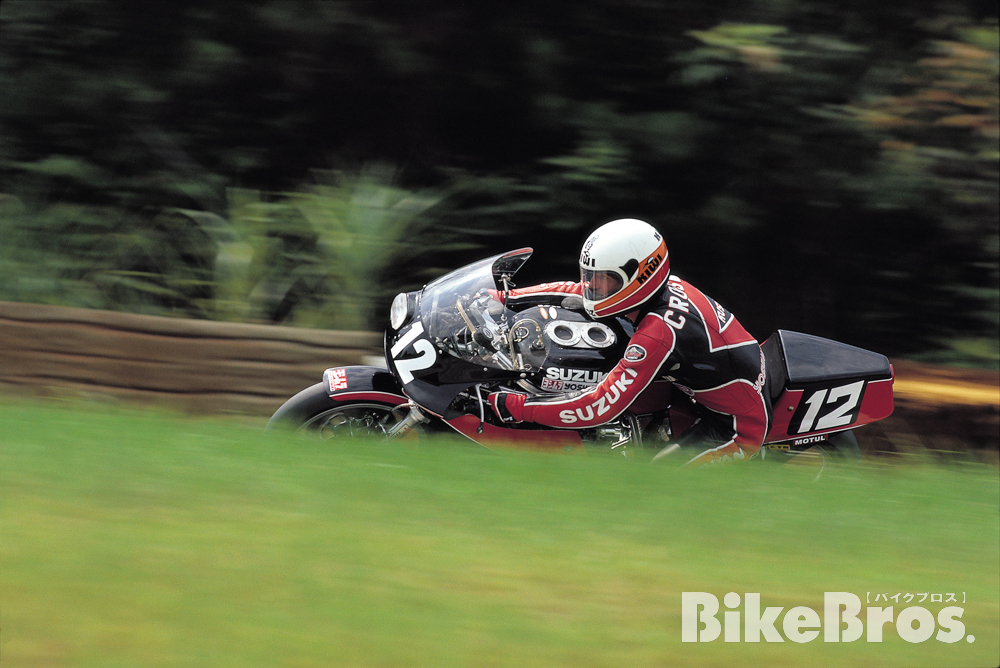
Graeme Crosby taking pole at the 1983 Suzuka 8 Hours aboard the Yoshimura-Moriwaki-Suzuki GSX1000SZ. This was Pop’s only racing collaboration with his daughter and her husband: Namiko and Mamoru Moriwaki. Yoshimura and Moriwaki are a family but also rivals. They respect each other as they walk their own paths.
Yoshimura History #19: Yoshimura History 19: The Dawn of the 750cc Era
The New 750cc Rules
Fujio and US Yoshimura (Yoshimura R&D of America) staff had a hectic 1982 season with the development of the Yoshimura Suzuki GSX1000SZ Katana for the AMA Superbike. Shortly before that, in the spring of 1981, US Yoshimura moved from North Hollywood to an industrial park in Chino, a suburban city east of Los Angeles. Located adjacent to both Ontario and Pomona, and in close proximity to Riverside, Chino was an ideal environment for them with cutting-edge facilities and numerous racetracks in the area (20 years later, in 2001, the company moved to a new, more spacious facility in Chino).
In 1983, Yoshimura faced an ordeal. Firstly, Suzuki reduced its racing activities. Secondly, the U.S. import tariff on foreign motorcycles over 700cc was raised drastically by 45 percentage points from 4.4% to 49.4%. It was a Presidential Memorandum —- Memorandum on Heavyweight Motorcycle Imports, aka the 1983 motorcycle tariff, which was intended to scale back over the following 5 years but ended early in 1987 —- to protect homegrown Harley Davidson by keeping out Japanese bikes. This was a major blow to Yoshimura; whose main products were mufflers for the 750cc and 1000cc classes. The company ran into financial difficulties and, for the first time, suspended its AMA racing activities, which they had been doing since 1971.
Also in 1983, the AMA Superbike regulations were changed and the maximum displacement was lowered from 1025cc to 750cc. Yoshimura’s ace rider Wes Cooley transferred to U.S. Kawasaki and became teammate of Wayne Rainey. The Superbike machines were completely redesigned to meet the new 750cc regulations. The air-cooled inline-4 Kawasaki GPz750R and the liquid-cooled V-4 Honda VF750F went head-to-head, with Wayne Rainey winning the championship.
As a desperate —- and somewhat absurd —- attempt to avoid the heavy tariff, Japanese manufacturers developed various 700cc bikes (such as Suzuki GSX700E) for their U.S. export lineup by reducing the engine capacity of their 750’s.
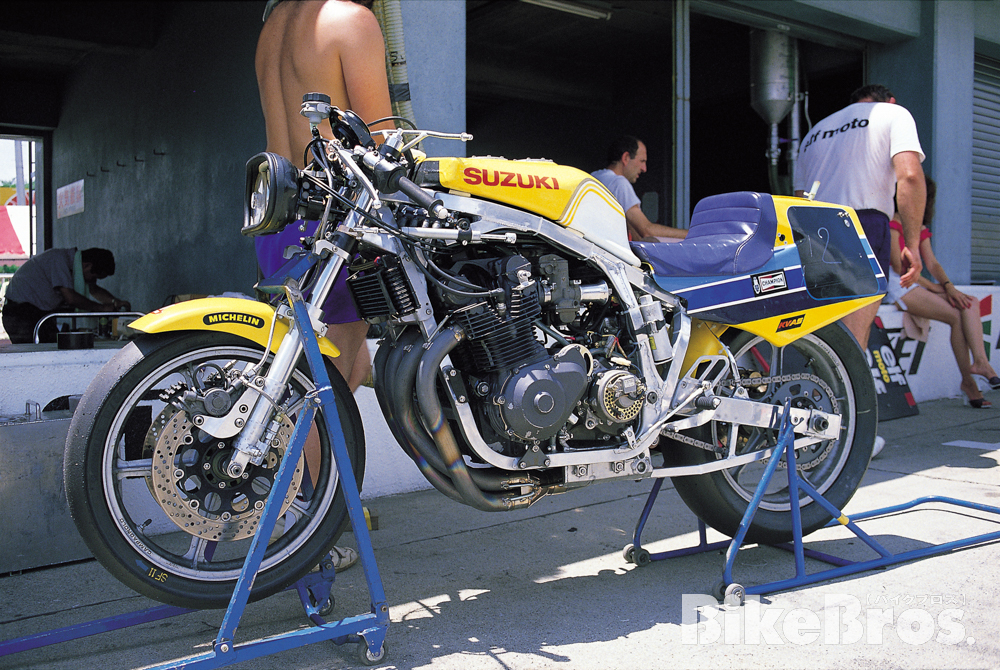
The 1983 Yoshimura Suzuki GS1000R had a double-cradle frame made of square-section aluminum tubing, and the rear suspension was a single Full-Floater shock with upper and lower shock mounts on the swingarm. Both the rear shock and ANDFs (Anti Nose Dive Forks) were KYB factory specials. 18″ cast magnesium Campagnolo wheels were chosen for both the front and rear, and the front brake calipers were AP Lockheed’s. The Yoshimura-tuned engine had a twin-plug head and was paired with a Yoshimura Cyclone exhaust. Note the Cyclone’s unique, optimized collector arrangement corresponding to the 1-2-4-3 firing order.
Meanwhile, Yoshimura’s Japanese operation, Yoshimura Parts of Japan, lost its support from Suzuki in 1983 due to Suzuki’s downsizing of its racing program, including the Suzuka 8 Hours. They had never experienced this situation since 1976, when Suzuki engineer Etsuo Yokouchi and Pop met and signed a gentleman’s agreement for mutual cooperation. Since Suzuki had been in charge of the chassis, it was no longer possible for Yoshimura alone to compete in the Suzuka 8 Hours. That was where the family came in. Moriwaki Engineering, a tuning manufacturer company established by Pop’s eldest daughter Namiko and her husband Mamoru Moriwaki in Suzuka City, has been building their own frame since early on.
Moriwaki Engineering debuted their racer frame for large-displacement engines at the 1979 Suzuka 8 Hours, and just a year later, in 1980, U.S. Kawasaki factory riders Eddie Lawson and Gregg Hansford, as well as others including David Aldana and David Emde raced Moriwaki-framed Kawasaki’s in big events such as the Daytona 200 and Suzuka 8 Hours. Mated with Z1/Z1000J engines (Moriwaki strengthened its relationship with Kawasaki after Yoshimura formed a cooperative relationship with Suzuki), these machines had quickly proven themselves to be very competitive and soon they came to be known as the “Moriwaki Monster”.
When then-unknown Australian newcomer Wayne Gardner set the TT-F1 course record of 2:14.76 to take pole position at the 1981 Suzuka 8 Hours, he was riding a Moriwaki Monster with a double-cradle frame made of extruded aluminum. This was the so-called “Aluminum Monster”, while the pre-1980 models were called the “Iron Monster”.
In 1983, Moriwaki provided Yoshimura with an aluminum double-cradle frame developed from the preceding 1982 model, which, instead of the single rear suspension that was becoming popular at the time, had a conventional twin-shock configuration for better traction. The Yoshimura-Moriwaki-Suzuki team, racing a Moriwaki-framed GSX1000SZ Katana, was thus born and became an archrival to the Moriwaki-Kawasaki team racing a Moriwaki-framed Z1000J.
Yoshimura entered Graeme Crosby aboard the Moriwaki-framed GSX1000S in the Suzuka 200km race, a prelude to the Suzuka 8 Hours, and, on the new course with an added chicane before the last corner, Crosby set a lap record of 2:25.95.
In the 1983 Suzuka 8 Hours, Yoshimura-Moriwaki-Suzuki team entered with Crosby and Rob Phillis. Crosby took the pole by breaking his own lap record, setting a new mark of 2:23.11. In the main race, however, the new machine was plagued by an oil leak from the cylinder head cover and finished 12th. Moriwaki-Kawasaki team entered the race with Kunihiro Mikami and Shunji Yatsushiro, and had a good race finishing 6th as the highest-placed privateer team.
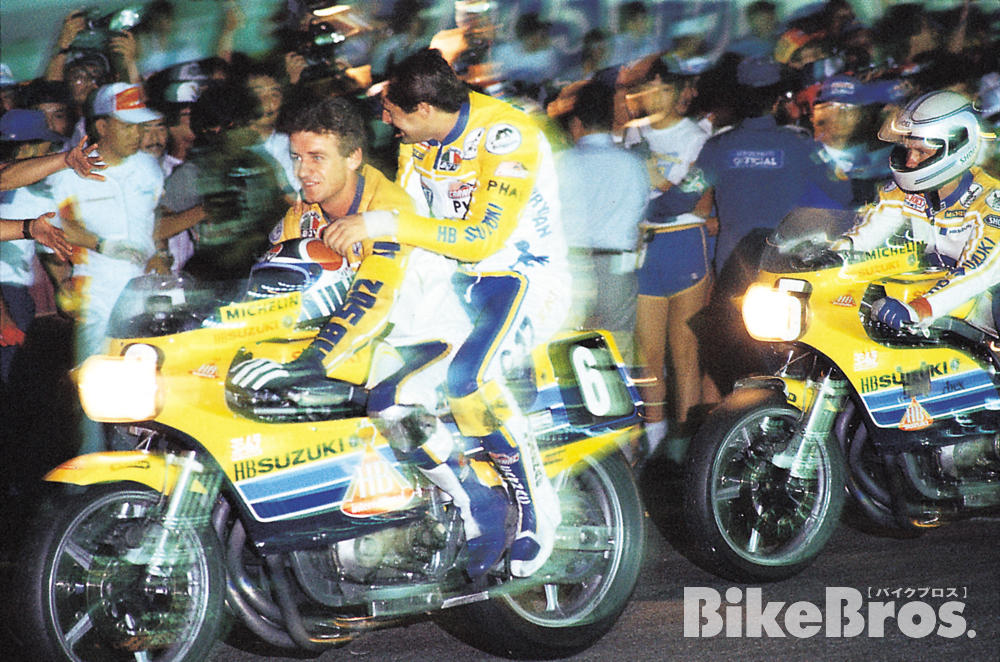
Suzuki France (the predecessor of today’s SERT) took the win (#6 Herve Moineau / Richard Hubin) and 5th place (#5 Pierre-Etienne Samin / Dominique Pernet) in the 1983 Suzuka 8 Hours. After the checker, Hubin made the winning run with Moineau as the two became Suzuki’s first World Endurance Champions (Moineau’s second, for he had previously won the title with Honda in 1980).
The winning machine was a Suzuki France GS1000R (XR41) ridden by Herve Moineau and Richard Hubin. The engine was based on the 8-valve GS1000 and was tuned by Yoshimura in Japan (Yoshimura Parts of Japan), with a twin-plug head and a Yoshimura Cyclone exhaust. The Suzuki France team was fast for an endurance racing team. In fact, it was the first “endurance racing team” to win the Suzuka 8 Hours —- and eventually became that year’s FIM Endurance World Champion —- which in reality has been a “sprint endurance race”. The FIM TT-F1 category races and the Endurance World Championship then concluded the 1000cc era and moved into the new 750cc era from 1984.
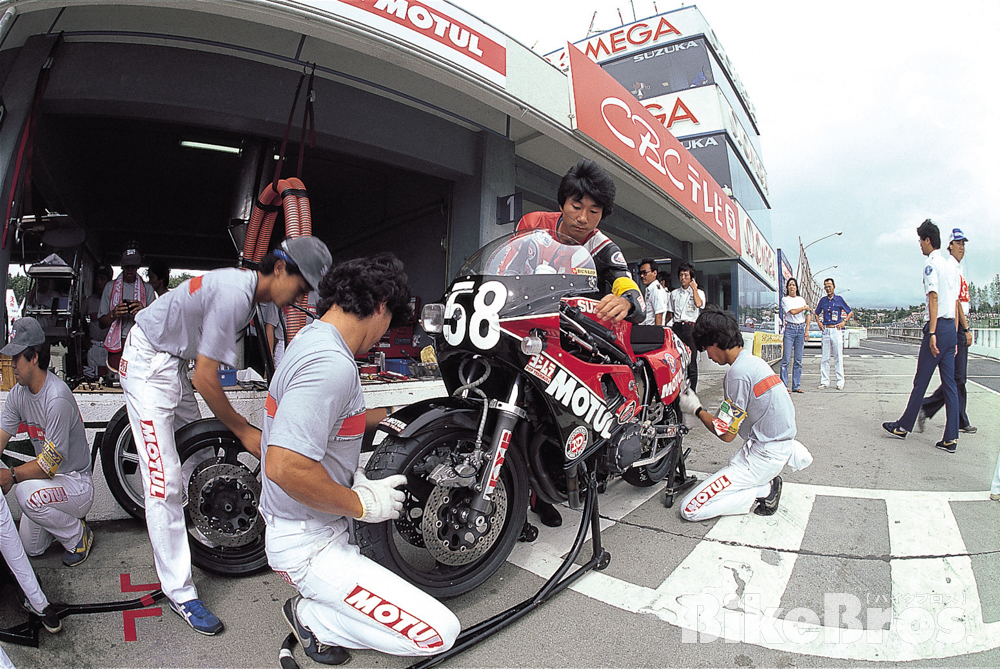
Yoshimura rider Noboru Miura (standing behind the bike) works on #58 GSX750ES, ridden by him and Nao Ikeda in the 1984 Suzuka 8 Hours. The bike was constructed on a double-cradle chromoly steel tubular frame and featured twin-shock rear suspension. It had KYB front and rear suspensions, but the front forks did not have the ANDF mechanism found on the #12 GSX750ES (built on an aluminum frame and with Full-Floater monoshock rear). The exterior of the bike was also very different from #12; including the front fairing, fuel tank (with a vertical rear-end design) and rear fairing (sloping downwards to the rear). The carbs on #58 are Mikuni VM’s.
Pop decided to compete fully in the All Japan Road Race Championship races in 1984, when the MFJ (The Motorcycle Federation of Japan) added the TT-F1 and TT-F3 to the International A-class along with GP500, GP250 and GP125. Although MFJ had already established the Novice TT-F3 Class in 1983, this was the first time for the top road racing class in Japan.
Unlike the GP classes dominated by 2-stroke factory/production racers, the TT Formula classes were dominated by 4-stroke, modified production bikes (allowing free choice of chassis), which, miraculously coinciding with a huge domestic “bike boom”, had a great impact on the sales of new motorcycles, 400cc sports bikes in particular. This was also boosted by the success of the 1983 events, which attracted an audience of 139,000 for the Suzuka 8 Hours (Endurance World Championship, TT-F1) and 58,000 for the Suzuka 4 Hours (Novice TT-F3). A new wind had begun to blow through the GP-centric Japanese racing scene.
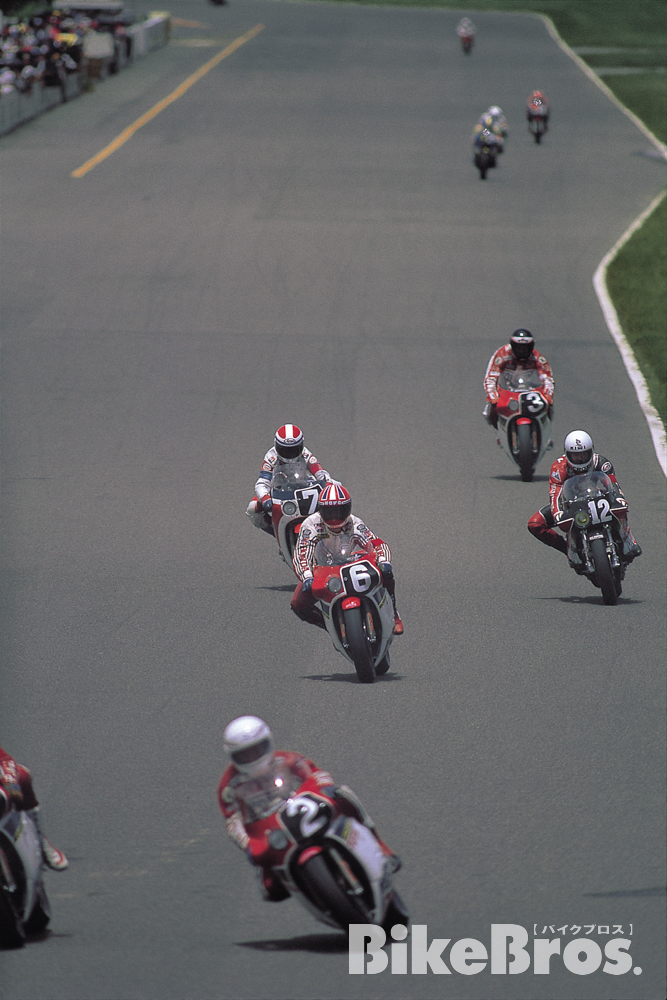
1984 Suzuka 8 Hours. #12 Graeme Crosby aboard GSX750ES is in the top group at the beginning of the race. The top spot is occupied by #1 Mike Baldwin (only partially visible in the photo), who is followed by a pack of Honda RS750R’s; #2 Guy Bertin, #6 Raymond Roche, #7 Malcolm Campbell and #3 Gerard Coudray. Moriwaki’s #29 Shunji Yatsushiro is seen in the distance.
In response to Yoshimura’s commitment to the All Japan Road Race Championship, the Suzuki factory resumed the supply of chassis (including suspensions) and major engine components (crankshaft, transmission assemblies, and so on). The base machine for the TT-F1 was the GSX750ES (747cc air-cooled inline 4-cylinder with DOHC 4-valve head), and for the TT-F3 was the GSX-R400 (398cc liquid-cooled inline 4-cylinder with DOHC 4-valve head).
The riders were Noboru Miura and Nao Ikeda. Miura was born in Aomori Prefecture on September 2, 1961, and joined Yoshimura at the age of 22. He was promoted to the International B-class in 1983, and in the GP250 —- an International A-class mixed race —- he showed overwhelming speed, winning the overall championship and was promoted to the International A-class (he missed the International B-class championship due to an ignition failure during the final round). Ikeda, 25, was born in Miyazaki Prefecture on July 23, 1958, and made spot entry in the World GP250 in 1982 and 1983, and Pop had high hopes for the sprinting ability the two had developed in GP250.
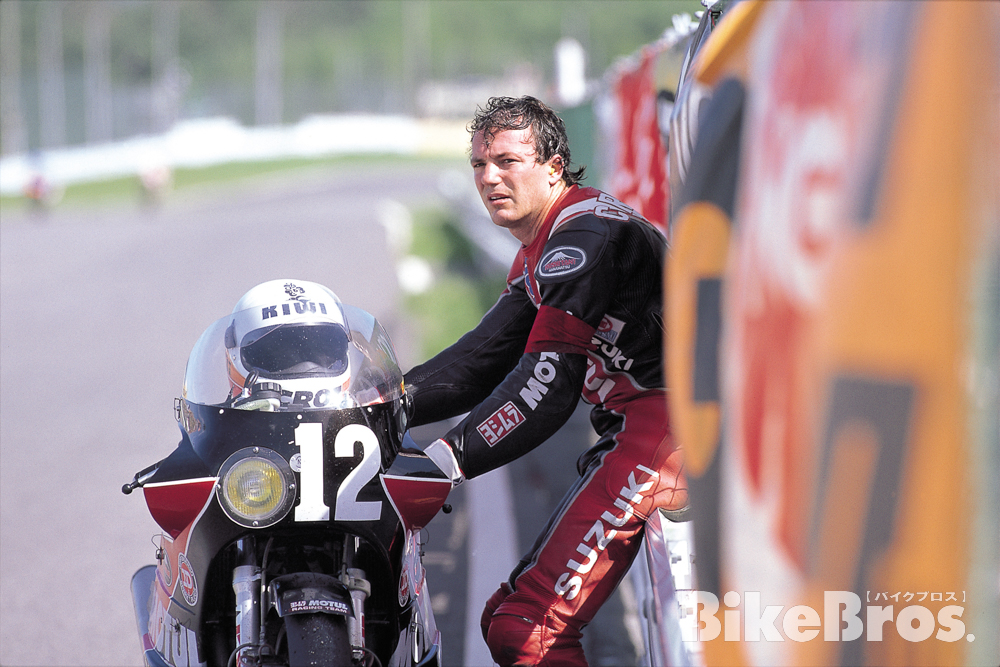
Retiring with a blown engine in the 1984 Suzuka 8 Hours. Crosby left the Grand Prix scene at the end of 1982 (after finishing 2nd in the ranking) and decided thereafter to ride only Yoshimura / Moriwaki machines. He was fed up with the political and commercial strategies of the GP, and had sought to work solely with a team that treated him like a family.
However, Yoshimura’s TT-F1 challenge did not work out well. The best results that the GSX750ES could achieve were Crosby’s 3rd place in the Suzuka 200km, his 3rd place in the All-Japan GP and Miura’s 4th place in the Suzuka 2&4 race in March. Miura and Ikeda had both been occasionally forced to retire from TT-F1 races due to the characteristics of the large-displacement 4-stroke engine (most especially the powerful engine brake), the heaviness of the bike (GSX750ES weighs 160-170kg without fuel, while the 1984 TZ250 weighs just 104kg dry) and other various factors that could cause malfunctions, such as the less-than-perfect balance of chassis and engine. In the 1984 TT-F1 season, Miura finished 7th in the ranking.
By contrast, in TT-F3 —- in which the bikes are lighter compared to those of TT-F1 —- both Miura and Ikeda achieved good results. Miura won 3 victories in 10 rounds, and finished 3rd in the ranking. Ikeda won 1 race and made 4th in the ranking.
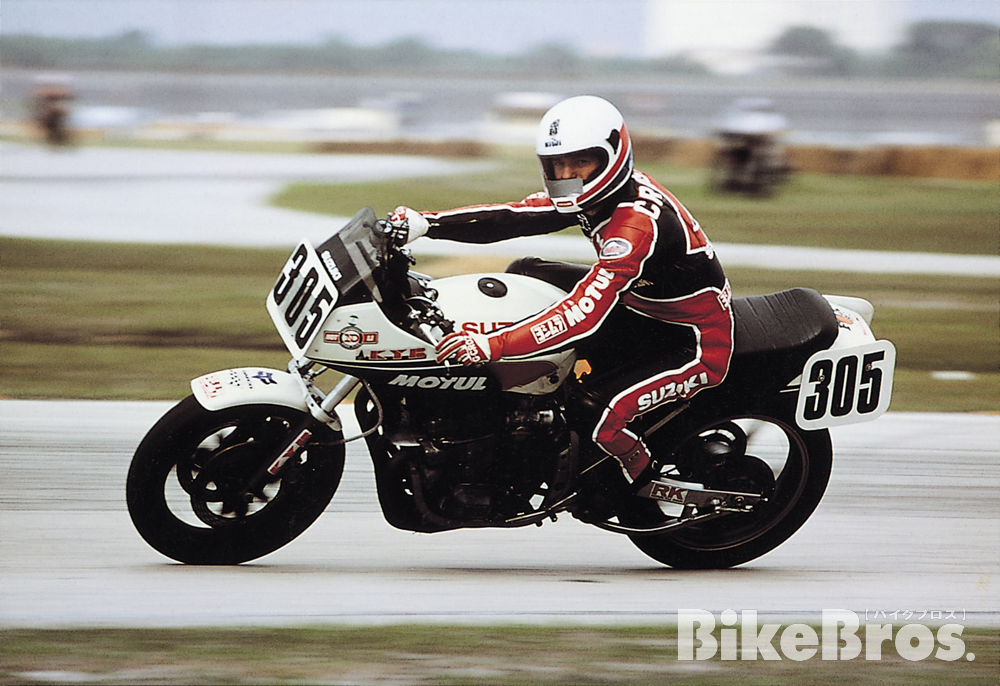
Noboru Miura was both a Super Novice and a Super International B-class rider. His speed gave the impression of unfathomable qualities, but at times it was a double-edged sword. He had a tendency to crash (usually by losing the front end). He did not get used to TT-F1 until the very end. In TT-F3, on the other hand, he used his speed to win 3 races.
For the 1984 Suzuka 8 Hours, Pop entrusted the aluminum double-cradle frame (rectangular tube construction with single rear shock) to Graeme Crosby / Len Willing, and the steel double-cradle frame (chromoly steel tube construction with twin rear shocks) to Noboru Miura / Nao Ikeda. However, Crosby / Willing (starting from the 3rd qualifying spot) and Miura / Ikeda retired after 82 laps and 95 laps respectively, due to blown engines.

Graeme Crosby racing a Yoshimura Suzuki GSX750E superbike. In 1984, after a one-year absence, Yoshimura returned to the Superbike, and both Crosby and Wes Cooley entered the Daytona season opener. Although Crosby did not enter every round of the season, and Cooley entered only in his hometown California rounds, Cooley grabbed a victory at Sears Point (Sonoma) in August.
Yoshimura returned to the AMA Superbike series in 1984 after a one-year absence. With a new Yoshimura Suzuki GSX750E superbike, Wes Cooley —- returning from U.S. Kawasaki —- and Graeme Crosby entered the season opening Daytona round, but they didn’t get to race the bike due to engine failure in the qualifying session.
At the 1984 Daytona 200, Crosby did well on a 4-stroke bike (1023cc GSX1000SZ engine mounted on an aluminum Moriwaki chassis), taking 7th place alongside Kenny Roberts and others on bored-out 2-stroke GP machines. After Daytona, Cooley competed only in the local California races. He raced well against liquid-cooled V4-powered Honda VF750F’s with a less competitive air-cooled bike; finishing 2nd in Riverside (April 15), winning Sears Point (August 18) and finishing 2nd in Willow Springs (September 16). The champion was Honda’s Fred Merkel, who also rode the Yoshimura Katana in 1982.
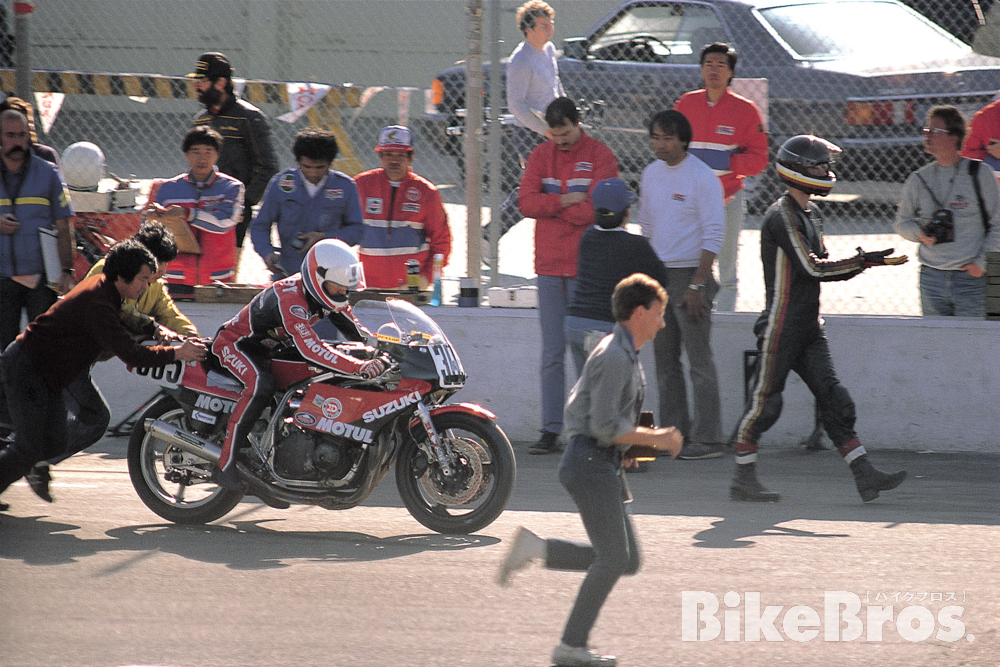
In 1984 Daytona 200, Crosby qualified in the 6th spot and finished in 7th. His bike was essentially a bored-out version of the 1983 Suzuka 8 Hours spec GSX1000S, which was constructed on an aluminum double-cradle Moriwaki frame (made of extruded aluminum) with twin rear shocks. Taking advantage of the new 4-stroke 1025cc rule, the engine was swapped with a 1023cc (φ70.9×64.8mm) version used on Yoshimura Suzuki GSX1000SZ Katana.
Under the new 750cc rule, the performance of air-cooled engines were becoming increasingly inferior to that of rivals in both FIM TT-F1 (both World and All-Japan) and AMA Superbike racing scenes. Yoshimura needed a new machine.
============================================================
Published on April 20, 2022
Stories and photos supplied by Yoshimura Japan / Namiko Moriwaki / Cycle World / Tomoya Ishibashi
Written by Tomoya Ishibashi
Edited by Bike Bros Magazines
[ Japanese Page ]
